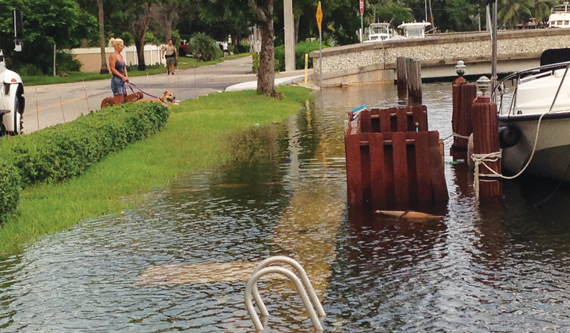Last fall, media reports showed mullet fish swimming along flooded Fort Lauderdale streets during a “king tide” — the exceptionally high seasonal tide that has become a more common and more problematic occurrence over the past few years. The scene made for a compelling story, and some articles even compared the city’s problems to those of Venice, the picturesque yet sinking Italian city, raising concerns about rising sea levels in this rapidly growing coastal community, where pricey homes and condos abound.
The 38-square-mile Broward County seat, which on average is about seven to eight feet above sea level, has seven miles of coastline and 165 miles of canals and navigable waterways, as well as other water channels. Elevations differ throughout the city: Fort Lauderdale Beach is around 10 feet above sea level, while inland areas are much lower.
Built to last
Developers with an eye on the rising tide are getting resourceful. Stephen Tilbrook, a shareholder at local law firm Gray Robinson, said that some developers are building resiliency — a term for the ability to absorb changes caused by climate change and continue to function — into their new properties and redevelopments, despite the costs. However, he said there were plenty of other developers for whom sea levels are “not at the forefront of their minds.”
 Peter Flotz, managing member of FLL Development Enterprise — part of the Lansing Melbourne Group — is one of the developers for the estimated $750 million redevelopment of Galleria Mall in Fort Lauderdale, which will include residential and commercial properties. “We rely primarily on FEMA and the judgment of our engineers to establish base floor elevations for our projects,” Flotz said in reference to the rising seal level. “We also find that the market is starting to demand that we design and build resilient projects that can adapt quickly to climate change.”
Peter Flotz, managing member of FLL Development Enterprise — part of the Lansing Melbourne Group — is one of the developers for the estimated $750 million redevelopment of Galleria Mall in Fort Lauderdale, which will include residential and commercial properties. “We rely primarily on FEMA and the judgment of our engineers to establish base floor elevations for our projects,” Flotz said in reference to the rising seal level. “We also find that the market is starting to demand that we design and build resilient projects that can adapt quickly to climate change.”
But, he noted, when resiliency features are added to defend against rising sea levels, “the costs are staggering, and difficult to assess because they are unpredictable.”
Nancy Gassman, assistant public works director in the sustainability division for the City of Fort Lauderdale, said that recently she has been spending a lot of time with South Florida realtors talking about sea level rise.
Gassman told The Real Deal about the wide range of actions the city has taken to combat the effects of sea level rise. These include an ordinance change allowing seawalls to reach 3.9 feet above a specific tidal benchmark; repairing and raising municipal seawalls; installing backflow valves, which allow water to run out to the shore but block seawater from entering the city’s rainwater control system; cleaning and repairing the municipal storm water system; adding more pumps; building berms and other structures to protect beaches, roads and property; and carrying out an education program for citizens. The city has identified areas that are particularly vulnerable to flooding, and it is concentrating its efforts in these zones.
But still, sea level rise is an accelerating, long-term problem. Citing figures from the Southeast Florida Regional Climate Change Compact, Gassman said that the sea level in the region has risen by three inches since 1992, and it’s projected to rise six to 10 inches by 2030 and 14 to 26 inches by 2060.

A rendering of the Galleria Mall redevelopment
And sea rise isn’t the only water problem confronting southeast Florida. “We have to plan for sea level rise, coastal erosion, tidal flooding, inland storm flooding and the impact of storms and hurricanes,” she said.
Financial impact
Given such long-term threats, some ask when banks and other finance companies will realize that there might be a problem approving 30-year mortgages. Not soon, one expert said.
“When you’re talking about coastal property east of I-95, most of the buyers are from out of town or are profit-oriented buyers,” Peter Zalewski, founder and principal of Condo Vultures, a Miami-based real estate consultancy, told TRD.
“The horizon on the investment is much shorter than Mother Nature’s ability to raise sea levels,” Zalewski said. “And for the people who can afford to buy east of 95 and keep their properties for the long term…the expiration date for the owner will likely come before sea level rise occurs.”
Sales prices
Despite the concerns, industry experts told TRD residential prices have not been affected. Statistics released in January by the Greater Fort Lauderdale Realtors show that both median and average sales prices for condos, townhouses and single-family homes rose in December 2016 compared to December 2015. However, closed sales and new listings for these three categories fell in December 2016.
“The potential for sea level rise has not impacted property values and likely will not have an impact in the near future,” said John Beauchamp, president of Fort Lauderdale-based Intercoastal Realty, whose company sells condos and homes ranging up to $20 million or more in coastal areas of Broward. “Build-to-suit and speculative development of luxury homes has returned to the area, causing increases in land values for older/smaller homes.”
That’s not to say that some buyers don’t have water worries on their minds — and with good reason. “In southeast Fort Lauderdale, the king tides did impact a number of streets,” Beauchamp said, with water sometimes reaching as high as 10 inches. He noted that most of the flooding was caused by a lack of backflow valves. The city has installed new valves in the affected areas.
Still, he noted, “Rising sea levels and hurricanes may deter some potential buyers. [But] they are far outnumbered by buyers seeking year-round warm weather and sunshine — not to mention low taxes.”
